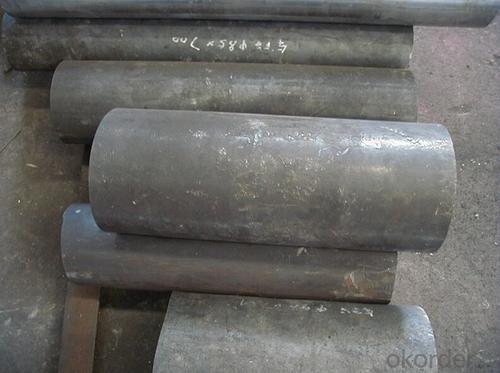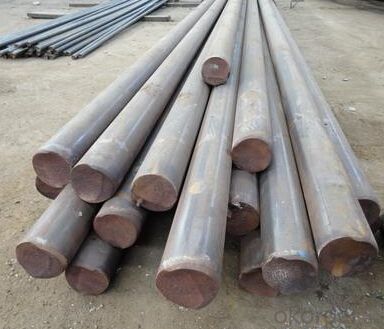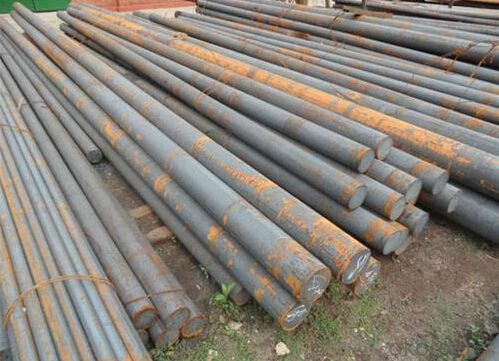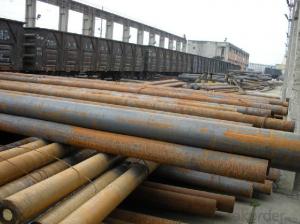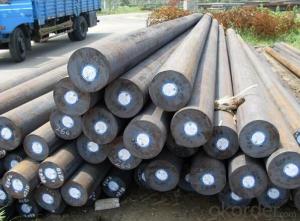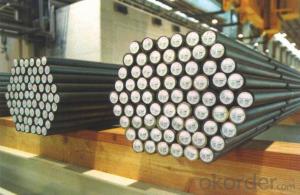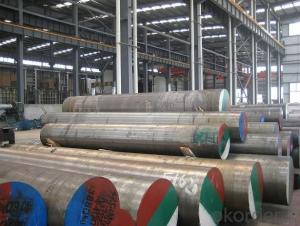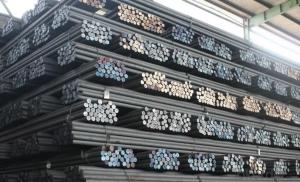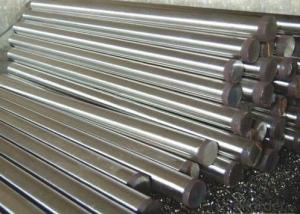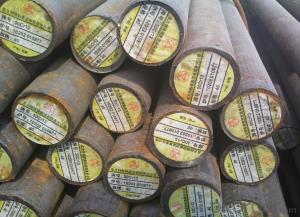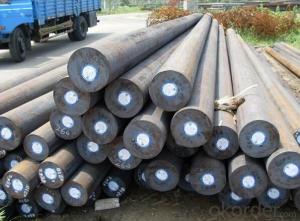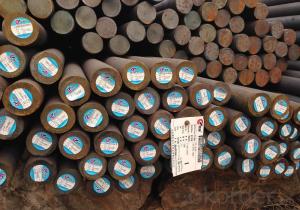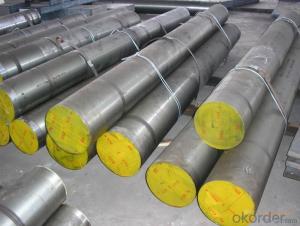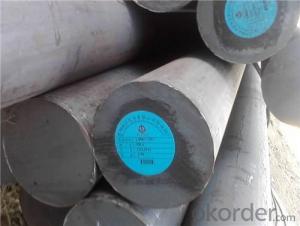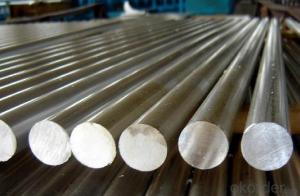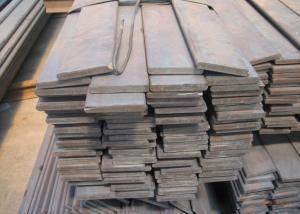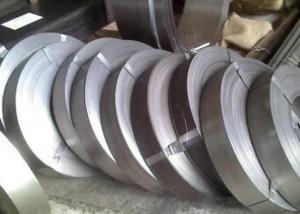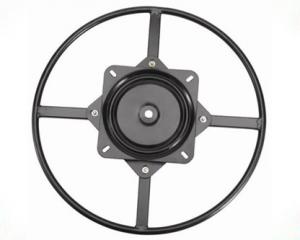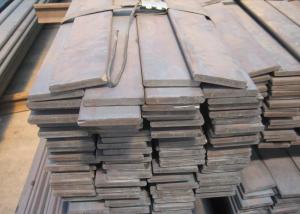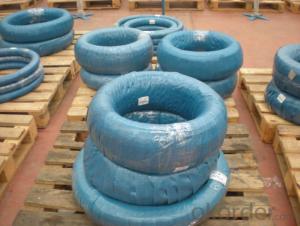DIN 1.7225/AISI 4140 Mould Steel Round Bar
- Loading Port:
- Shanghai
- Payment Terms:
- TT OR LC
- Min Order Qty:
- 3 m.t.
- Supply Capability:
- 100000 m.t./month
OKorder Service Pledge
OKorder Financial Service
You Might Also Like
Specification
DIN 1.7225/AISI 4140 Mould Steel Round Bar
Details Information of DIN 1.7225/AISI 4140 Mould Steel Round Bar
| Name | DIN 1.7225/AISI 4140 Mould Steel Round Bar |
| Shape | Round Bar/Square Bar/Flat Bar/Plate/Wire |
| Standard | GB/ASTM/SAE/AISI/DIN/JIS/EN/BS |
| Surface Treatment: | Black/Peeling/Polished/Machined |
| Delivery Condition: | Hot Rolled or Forged/Peeled or Black Surface |
| Test | SGS/UT 100% Elements Testing |
| Certificate: | ISO/Mill Certificate |
| Service: | 24 hours online service / |
| more than 20 years trading and manufacture | |
| Quality Assurance: | the third party inspection, such as SGS, BV, TUV…etc. is acceptable |
| Packaging Details: | Seaworthy Packaging or as per customer's packing instruction |
| Carbon structure round bar | Q195 Q235A Q235B 10# 20#-55# S45CB |
| Low alloy high strength round bar | Q345A/Q345C/Q345D Q345B Q345E |
| Alloy structure round bar | SAE51B20 20Cr 40Cr 40CrV 20CrMo/30CrMo/35CrMo/42CrMo 20CrMoA/30CrMoA/35CrMoA/42CrMoA/42Cr ML20CrMo/ML30CrMo/ML35CrMo/ML42CrMo B7/SCM435-440 20MnTiB 20CrMnMo 20CrMoH 42CrMoH 40MnB/40MnBH 30Mn2-40Mn2 27SiMn 50CrVA 30CrMnTi |
| Pinion steel | 20CrMnTi 20CrMnTiH 20CrMnTiHCS/20CrMnTiHLD Q20CrMnTi-1/Q20CrMnTi-2 |
| Sucker rod | 20-35CrMoA |
| Free-cutting steel | GT1215S |
| Spring steel | 60Si2MnA 65Mn |
| Ball bearing steel | GCr15 |
Chemical Composition of DIN 1.7225/AISI 4140 Mould Steel Round Bar
| C | Si | Mn | P | S | Cr | Ni | Cu |
| 0.17-0.24 | 0.17-0.37 | 0.35-0.65 | ≤0.035 | ≤0.035 | ≤0.25 | ≤0.25 | ≤0.25 |
| Tensile strength (σb/MPa) | Yield strength (σb/MPa) | Elongation (δ5/%) |
| ≥410(42) | ≥245(25) | ≥25 |
Company Introduction of DIN 1.7225/AISI 4140 Mould Steel Round Bar
CNBM International Corporation is the most import and export platform of CNBM group(China National Building Material Group Corporation) ,which is a state-owned enterprise, ranked in 270th of Fortune Global 500 in 2015.
With its advantages, CNBM International are mainly concentrate on Cement, Glass, Iron and Steel, Ceramics industries and devotes herself for supplying high quality series of refractories as well as technical consultancies and logistics solution.
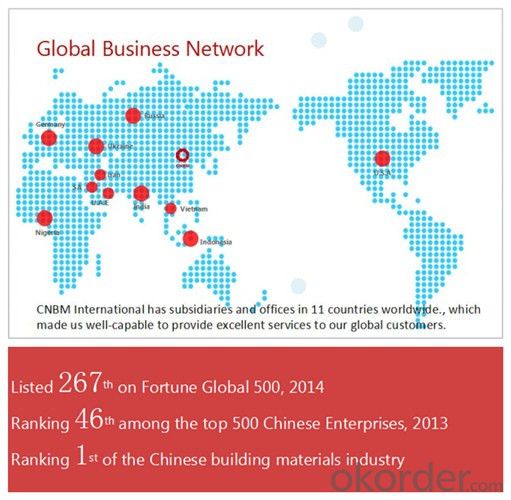
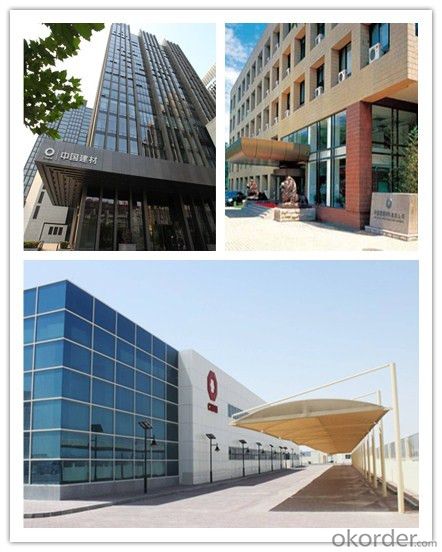
Certificates of DIN 1.7225/AISI 4140 Mould Steel Round Bar
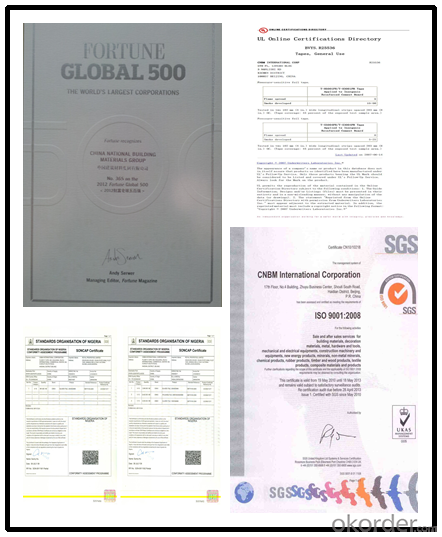
Packaging & Delivery of DIN 1.7225/AISI 4140 Mould Steel Round Bar
Packaging Detail | Sea worthy packing /as per customer's packing instruction |
Delivery Detail | 15 ~ 40 days after receiving the deposit |
Products show of DIN 1.7225/AISI 4140 Mould Steel Round Bar
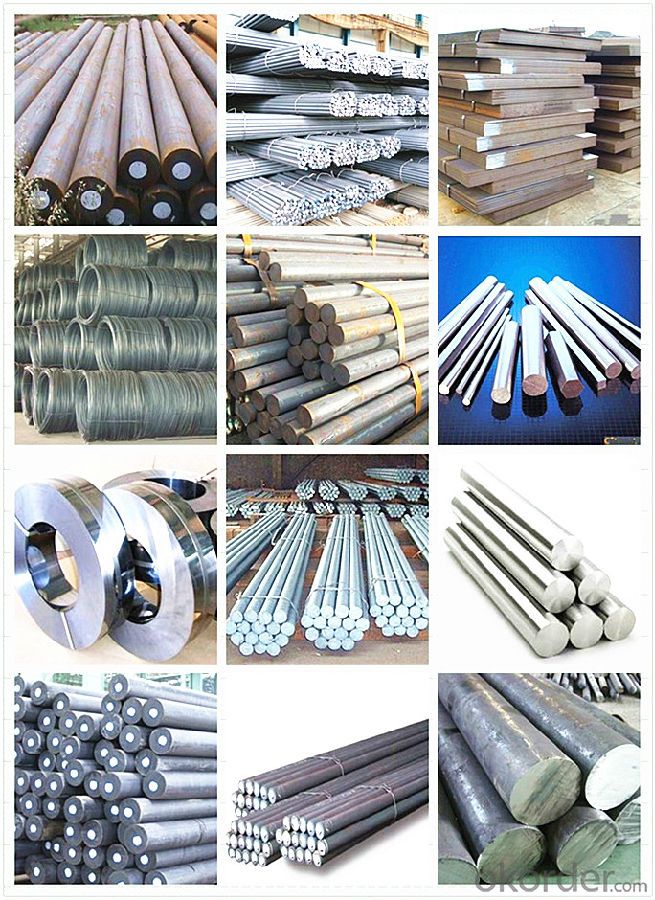
FAQ
Are you a trading company or manufacturer? | Manufacturer |
What’s the MOQ? | 3 metric ton |
What’s your delivery time? | 15-35 days after downpayment received |
Do you Accept OEM service? | Yes |
what’s your delivery terms? | FOB/CFR/CIF |
What's the Payment Terms? | 30% as deposit,70% before shipment by T/T |
Western Union acceptable for small amount. | |
L/C acceptable for large amount. | |
Scrow ,Paybal,Alipay are also ok | |
Why choose us? | Chose happens because of quality, then price, We can give you both. Additionally, we can also offer professional products inquiry, products knowledge train (for agents), smooth goods delivery, excellent customer solution proposals. |
What's your available port of Shipment? | Main Port, China |
What’s your featured services? | Our service formula: good quality+ good price+ good service=customer's trust
|
Where are your Market? | Covering more than 160 countries in the world |
- Q: Can special steel be cast?
- Yes, special steel can be cast. Castings of special steel are produced using various casting methods such as investment casting, sand casting, or continuous casting, depending on the specific requirements and properties of the steel.
- Q: How does special steel perform in chemical resistance applications?
- Special steel is known for its exceptional performance in chemical resistance applications. Its composition and properties make it highly resistant to corrosion and damage caused by exposure to various chemicals. Special steel is made using alloys that contain elements like chromium, nickel, and molybdenum, which provide excellent resistance to acids, alkalis, and other corrosive substances. In chemical resistance applications, special steel offers several advantages. Firstly, it exhibits high resistance to pitting corrosion, which is the localized corrosion that occurs on the surface of metals. This makes it suitable for use in environments where chemicals can cause damage to the metal surface. Secondly, special steel has excellent resistance to crevice corrosion, which is the corrosion that occurs in confined spaces or gaps between metal surfaces. This property is particularly beneficial in chemical processing equipment, where tight joints and connections are common. Furthermore, special steel maintains its mechanical strength and integrity in harsh chemical environments. It can withstand high temperatures, pressure, and exposure to aggressive chemicals without compromising its structural integrity. This makes it extremely reliable and durable, ensuring a longer service life and reduced maintenance costs. Overall, special steel's exceptional chemical resistance properties make it a preferred choice for a wide range of applications. Whether it is used in chemical processing plants, pharmaceutical industries, or oil and gas refineries, special steel provides the necessary protection against corrosion and damage caused by chemicals. Its ability to withstand harsh environments and maintain its performance over time makes it an ideal material for chemical resistance applications.
- Q: Can special steel be used in the agricultural equipment manufacturing industry?
- Yes, special steel can be used in the agricultural equipment manufacturing industry. Special steel, which includes alloys such as stainless steel and high-strength steel, offers superior strength, durability, corrosion resistance, and heat resistance properties. These qualities make it suitable for various agricultural equipment components like plows, tillers, harvesters, and machinery parts. Special steel can enhance the performance and lifespan of agricultural equipment, ensuring that they can withstand the demanding conditions and rigorous use in the industry.
- Q: What are the different surface treatments available for special steel?
- There are several surface treatments available for special steel, including galvanizing, powder coating, electroplating, passivation, and nitriding. These treatments enhance the steel's durability, corrosion resistance, appearance, and overall performance in various applications.
- Q: How is special steel used in the production of cutting blades?
- Special steel is used in the production of cutting blades because it possesses unique properties that make it highly durable, resistant to wear and tear, and capable of maintaining a sharp edge for longer periods of time. This type of steel is often chosen for its high hardness, toughness, and corrosion resistance, making it ideal for manufacturing cutting blades that can withstand intense cutting forces and harsh working environments.
- Q: What are the properties of wear-resistant stainless steel?
- Wear-resistant stainless steel possesses properties such as high hardness, excellent corrosion resistance, and good toughness. It is designed to withstand abrasion, erosion, and wear caused by friction, making it ideal for applications where durability and long-lasting performance are crucial, such as in industrial machinery, cutting tools, and automotive components.
- Q: What are the common applications of special steel in the manufacturing industry?
- Special steel, known as alloy steel as well, has unique properties and superior performance, making it widely used in the manufacturing industry for various applications. Different sectors benefit from special steel in the following ways: 1. Automotive Industry: Components like engine parts, gears, axles, and crankshafts heavily rely on special steel due to its high strength, durability, and resistance to wear and corrosion. Its exceptional performance in critical automotive applications makes it the preferred choice. 2. Aerospace Industry: In the aerospace sector, special steel is vital for manufacturing aircraft components such as landing gear, turbine blades, and structural parts. Its high tensile strength, lightweight nature, and ability to withstand extreme temperatures ensure the safety and efficiency of aircraft operations. 3. Construction Industry: The construction sector extensively uses special steel for manufacturing structural elements like beams, columns, and reinforcement bars. Its superior strength, ductility, and resistance to external forces guarantee the structural integrity and safety of buildings, bridges, and other infrastructure projects. 4. Oil and Gas Industry: The oil and gas industry relies heavily on special steel for manufacturing pipelines, drill bits, valves, and other equipment. Its high resistance to corrosion, pressure, and extreme temperatures make it suitable for handling the harsh operating conditions encountered in oil and gas exploration, extraction, and transportation. 5. Tool and Die Making: Special steel is commonly employed in tool and die making due to its excellent hardness, toughness, and wear resistance. Various industries, including automotive, aerospace, and consumer goods manufacturing, utilize special steel for manufacturing cutting tools, molds, dies, and punches. 6. Medical Industry: The medical industry utilizes special steel for manufacturing surgical instruments, implants, and medical devices. Its biocompatibility, corrosion resistance, and sterilizability ensure the safety and effectiveness of medical tools and implants. These examples represent only a fraction of the applications of special steel in the manufacturing industry. Its versatility, reliability, and performance contribute to the advancement and growth of various manufacturing processes in numerous sectors.
- Q: What are the main characteristics of tool steel forgings?
- Tool steel forgings have several main characteristics that make them highly desirable for a variety of applications. First and foremost, tool steel forgings are known for their exceptional durability and strength. They are specifically designed to withstand high levels of stress, making them ideal for applications where toughness and resistance to wear and tear are crucial. This strength allows tool steel forgings to maintain their shape and integrity even under extreme conditions, such as high temperatures or heavy loads. Another key characteristic of tool steel forgings is their excellent hardness. Tool steel is able to achieve high levels of hardness through a process called quenching and tempering, which involves heating the steel to a specific temperature and then rapidly cooling it. This hardness makes tool steel forgings highly resistant to abrasion, making them suitable for cutting, shaping, and forming materials. Additionally, tool steel forgings exhibit excellent dimensional stability. This means that they have minimal distortion or shrinkage when subjected to heat or pressure, making them ideal for precision tooling applications. Their dimensional stability also ensures that the forgings maintain their accuracy and reliability over time, which is essential in industries such as manufacturing and engineering. Furthermore, tool steel forgings offer good machinability, meaning they can be easily shaped, drilled, and cut to meet specific requirements. This makes them versatile and adaptable for a wide range of applications, from forming complex shapes to creating intricate designs. Lastly, tool steel forgings have excellent wear resistance. This characteristic allows them to maintain their cutting edges and surfaces for extended periods, reducing the need for frequent sharpening or replacement. This wear resistance is particularly advantageous in industries such as automotive, aerospace, and tool manufacturing, where longevity and efficiency are paramount. In conclusion, the main characteristics of tool steel forgings include exceptional durability and strength, high hardness, excellent dimensional stability, good machinability, and excellent wear resistance. These characteristics make tool steel forgings highly sought after in various industries, where reliability, precision, and longevity are critical.
- Q: How does special steel perform in terms of fatigue strength?
- Special steel generally performs very well in terms of fatigue strength. Due to its unique composition and production process, special steel exhibits high resistance to the progressive and cumulative damage caused by cyclic loading. This makes it highly durable and reliable, even under repeated stress and strain, making it a preferred material for applications that require exceptional fatigue performance, such as aerospace, automotive, and heavy machinery industries.
- Q: How is special steel used in the aerospace sector?
- Special steel is extensively used in the aerospace sector due to its unique properties that make it suitable for various applications. One of the primary uses of special steel in the aerospace industry is for manufacturing aircraft engine components. These components, such as turbine blades, shafts, and casings, are subjected to extremely high temperatures, pressures, and stresses. Special steel, with its excellent heat resistance, high strength, and superior mechanical properties, enables these engine parts to withstand such harsh conditions, ensuring optimal performance and safety. Moreover, special steel is also utilized in the construction of aircraft structures, including wings, fuselage, landing gears, and other critical components. These structures need to be lightweight, yet strong enough to withstand the forces experienced during flight. Special steel alloys, such as stainless steel, are used to achieve this balance by providing excellent strength-to-weight ratios and corrosion resistance. Additionally, special steel finds application in aerospace fasteners, such as bolts, nuts, and screws. These fasteners must have exceptional strength and durability to ensure the structural integrity of the aircraft. Special steel alloys, like titanium alloys, are commonly used in this regard due to their lightweight nature, high strength, and resistance to corrosion. Furthermore, special steel is utilized in the production of aerospace tooling and equipment. These tools, such as molds, dies, jigs, and fixtures, need to be robust, wear-resistant, and capable of withstanding high temperatures and pressures during manufacturing processes. Special steel, with its excellent hardness, toughness, and heat resistance, makes it ideal for such applications. In summary, special steel plays a critical role in the aerospace sector by providing the necessary properties required for aircraft engine components, structures, fasteners, and tooling. Its unique characteristics of high strength, heat resistance, lightweight, and corrosion resistance make it an indispensable material in the production of reliable and high-performance aerospace systems.
Send your message to us
DIN 1.7225/AISI 4140 Mould Steel Round Bar
- Loading Port:
- Shanghai
- Payment Terms:
- TT OR LC
- Min Order Qty:
- 3 m.t.
- Supply Capability:
- 100000 m.t./month
OKorder Service Pledge
OKorder Financial Service
Similar products
Hot products
Hot Searches
Related keywords






